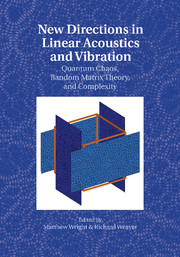Book contents
- Frontmatter
- Contents
- Foreword by Michael Berry
- Introduction
- 1 The Semiclassical Trace Formula
- 2 Wave Chaos for the Helmholtz Equation
- 3 The Unreasonable Effectiveness of Random Matrix Theory for the Vibrations and Acoustics of Complex Structures
- 4 Gaussian Random Wavefields and the Ergodic Mode Hypothesis
- 5 Short Periodic Orbit Theory of Eigenfunctions
- 6 Chaotic Wave Scattering
- 7 Transfer Operators Applied to Elastic Plate Vibrations
- 8 Mesoscopics in Acoustics
- 9 Diagrammatic Methods in Multiple Scattering
- 10 Time-Reversed Waves in Complex Media
- 11 Ocean Acoustics: A Novel Laboratory for Wave Chaos
- 12 Mesoscopic Seismic Waves
- 13 Random Matrices in Structural Acoustics
- 14 The Analysis of Random Built-Up Engineering Systems
- References
- Index
4 - Gaussian Random Wavefields and the Ergodic Mode Hypothesis
Published online by Cambridge University Press: 05 October 2010
- Frontmatter
- Contents
- Foreword by Michael Berry
- Introduction
- 1 The Semiclassical Trace Formula
- 2 Wave Chaos for the Helmholtz Equation
- 3 The Unreasonable Effectiveness of Random Matrix Theory for the Vibrations and Acoustics of Complex Structures
- 4 Gaussian Random Wavefields and the Ergodic Mode Hypothesis
- 5 Short Periodic Orbit Theory of Eigenfunctions
- 6 Chaotic Wave Scattering
- 7 Transfer Operators Applied to Elastic Plate Vibrations
- 8 Mesoscopics in Acoustics
- 9 Diagrammatic Methods in Multiple Scattering
- 10 Time-Reversed Waves in Complex Media
- 11 Ocean Acoustics: A Novel Laboratory for Wave Chaos
- 12 Mesoscopic Seismic Waves
- 13 Random Matrices in Structural Acoustics
- 14 The Analysis of Random Built-Up Engineering Systems
- References
- Index
Summary
The modeling of field distributions by Gaussian random wavefields is reviewed. Basic properties of Gaussian random functions are discussed and applied to the specific examples of randomly scattered fields (speckle patterns) and random eigenfunctions in chaotic enclosures, according to Berry's ergodic mode hypothesis. Sabine's law for reverberation time is derived for an ergodic random mode.
Introduction
The fact that deterministic wavefields in complex geometries can be represented and analyzed by statistical methods is an important assumption in many physical systems. In acoustics, such random-seeming deterministic fields can arise in scattering from a rough surface or in the spatial structure of the eigenfunctions of a perfectly resonant ergodic cavity. The random fields in the former case originate from approximating the surface roughness with randomly placed secondary sources, whose superposition gives rise to a random “speckle pattern,” typical for a wide range of wave scattering systems, especially laser light (Goodman 1985, 2007), and long studied in acoustics (Morse & Bolt 1944, Ebeling 1984). More surprising is Berry's hypothesis (Berry 1977), originally proposed in the context of quantum chaos, that a typical mode of an irregular cavity itself strongly resembles a typical Gaussian random function for high frequencies (i.e., in the semiclassical limit); again, this notion has existed in some sense for a long time in acoustics (Morse & Bolt 1944).
- Type
- Chapter
- Information
- New Directions in Linear Acoustics and VibrationQuantum Chaos, Random Matrix Theory and Complexity, pp. 59 - 76Publisher: Cambridge University PressPrint publication year: 2010
- 4
- Cited by

